Qiao Shizheng & Wang Haihui AM: Starting from the electronic state, playing with sodium-sulfur batteries with 2D MOF
QQ Academic Group: 1092348845
Detailed
Research Background
Metal-sulfur batteries have the advantages of abundant resources, low cost, and high theoretical energy density. They are a secondary battery with a large-scale energy storage prospect. However, the polysulfide generated during the discharge of metal-sulfur batteries will dissolve in the electrolyte and migrate to the negative electrode, and react with the metal negative electrode, resulting in lower Coulomb efficiency and rapid decay of capacity. At present, the combination of sulfur and carbon materials is mainly used to adsorb polysulfides on carbon materials to inhibit the dissolution of polysulfides in the electrolyte. Can lead to irreversible decomposition of polysulfides, leading to blockage of adsorption sites. Therefore, in order to achieve the effective limit of polysulfides in sulfur cathodes, it is necessary to meet appropriate adsorption energy and fast conversion kinetics. However, due to the complexity of polysulfides in the electrochemical conversion process, the current lack of in-depth understanding of the confinement mechanism of polysulfides has hindered the further development of sulfur cathode materials.
Achievements
Recently, the team of Professor Qiao Shihua of the University of Adelaide and the team of Professor Haihui Wang of South China University of Technology published a research paper entitled "Electron-State Confinement of Polysulfides for Highly Stable Sodium–Sulfur Batteries" on Adv. Mater. One author is Chao Ye. The authors use synchrotron radiation spectroscopy, electrochemical tests, and DFT calculations to prove that 2D Ni-MOF is a sulfur-loaded cathode material. During the charge and discharge process, the sulfur atomic material and sodium polysulfide are dynamically adjusted by the change of the local electronic state of the Ni atom. The interaction strength promotes the adsorption and kinetic conversion process of sodium polysulfide, realizes the effective limit of sodium polysulfide, and significantly improves the discharge specific capacity and cycle stability of room temperature sodium-sulfur batteries.
Research highlights
1. Using synchrotron in situ XRD, NEXAFS, electrochemical testing and theoretical calculations, it is proved that by changing the local electronic state of the sulfur cathode material, the strength of the interaction between polysulfide and electrode material can be dynamically adjusted to promote the The polysulfide adsorption strength and kinetic conversion process realize the effective limit of polysulfide.
2. The use of 2D Ni-MOF as a sulfur cathode material can effectively limit the sodium polysulfide and significantly improve the discharge specific capacity and cycle stability of room temperature sodium-sulfur batteries.
Graphic guide
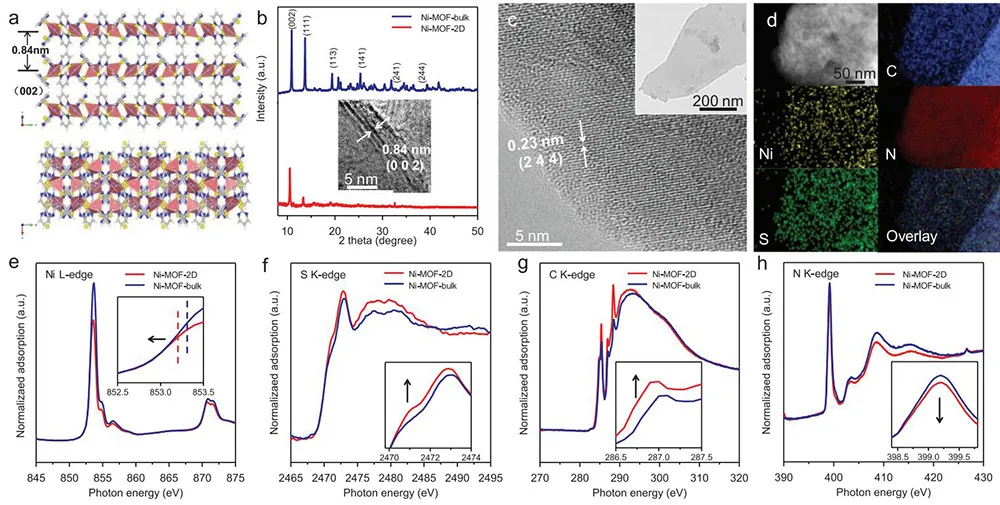
First, 2D Ni-MOF was prepared by wet ball milling and its microstructure and local electronic state were investigated. XRD showed that the 2D Ni-MOF obtained by mechanical peeling had the same initial crystal structure as the bulk Ni-MOF (Figure b). HRTEM and HAADF-STEM confirmed its 2D layered structure (Figures c, d), and its thickness was Up to 8.6 nm. Early research shows that the local electronic state of a sulfur cathode material is closely related to its discharge specific capacity and cycle stability. Therefore, the near-side X-ray absorption fine structure (NEXAFS) of bulk Ni-MOF and 2D Ni-MOF was tested to explore the local electronic state changes. The results showed that the localized charge of 2D Ni-MOF was redistributed after peeling. Among them, the electron part of the S atom is transferred to the Ni atom, and the electron part of the C atom is transferred to the N atom (Fig. E-h).
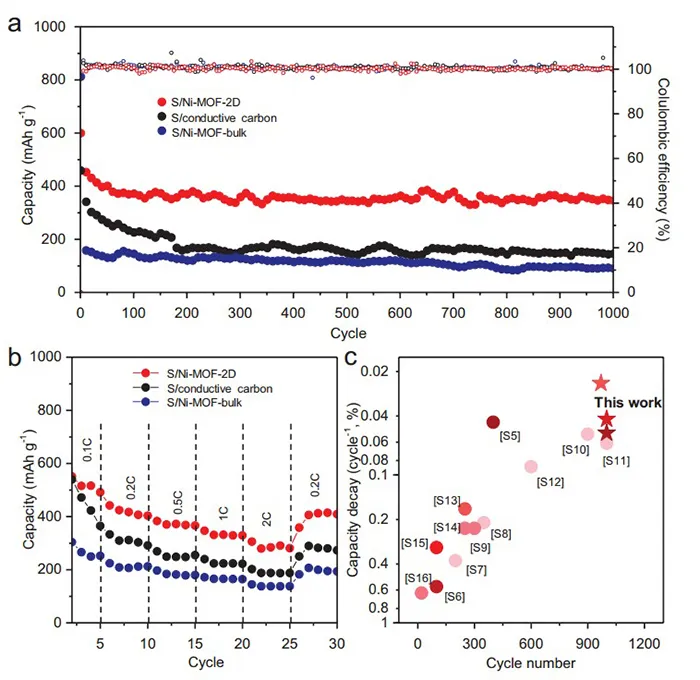
Electrochemical performance tests were performed on 3D Ni-MOF, bulk Ni-MOF, and conductive carbon sulfur anodes. 2D Ni-MOF sulfur cathode has excellent cycle stability and rate performance. After 1000 cycles at 1C rate, the discharge specific capacity is 347 mAh g-1, the average capacity decay per cycle is 0.042%, the Coulomb efficiency is close to 100%, and the performance is better than the room temperature sodium-sulfur battery recently published. The performance of bulk Ni-MOF and conductive carbon-sulfur cathodes is significantly worse.
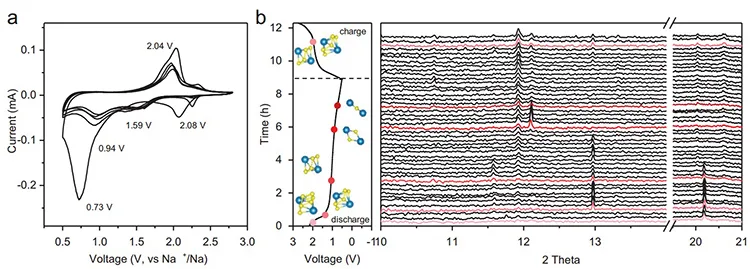
To investigate the mechanism of performance improvement, CV and in-situ synchrotron radiation XRD were used to study the conversion process of sodium polysulfide in 2D Ni-MOF. The results show that in the 2D Ni-MOF sulfur cathode, Na2Sx is formed at 1.6 V, 1 V, 0.8 V, and 0.7 V during the discharge process to form Na2S5, Na2S4, Na2S2, and Na2S, and is oxidized to Na2Sx when it is recharged. Kinetics of fast conversion of sodium sulfide on 2D Ni-MOF.
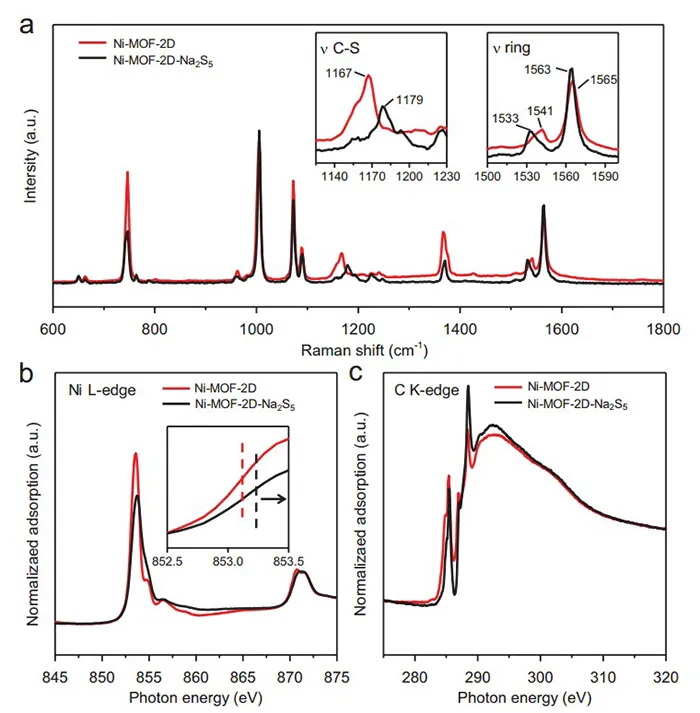
The adsorption mechanism of sodium polysulfide on 2D Ni-MOF was further studied by Raman spectroscopy and NEXAFS. Raman spectroscopy shows that there is a clear interaction between polysulfide Na2S5 and 2D Ni-MOF, and the electron density of S in the heterocyclic ligand will decrease (Figure a). NEXAFS further confirmed that the adsorption of sodium polysulfide will cause the charge transfer of Ni atoms in 2D Ni-MOF, the transfer of Ni atom electrons to the polysulfide through heterocyclic ligands, and the adsorption of Na2S2 and Na2S will lead to lower Ni atom electrons. State density. This shows that during the charge and discharge process, the electronic state density of Ni atoms changes dynamically (Figure 4b, c).
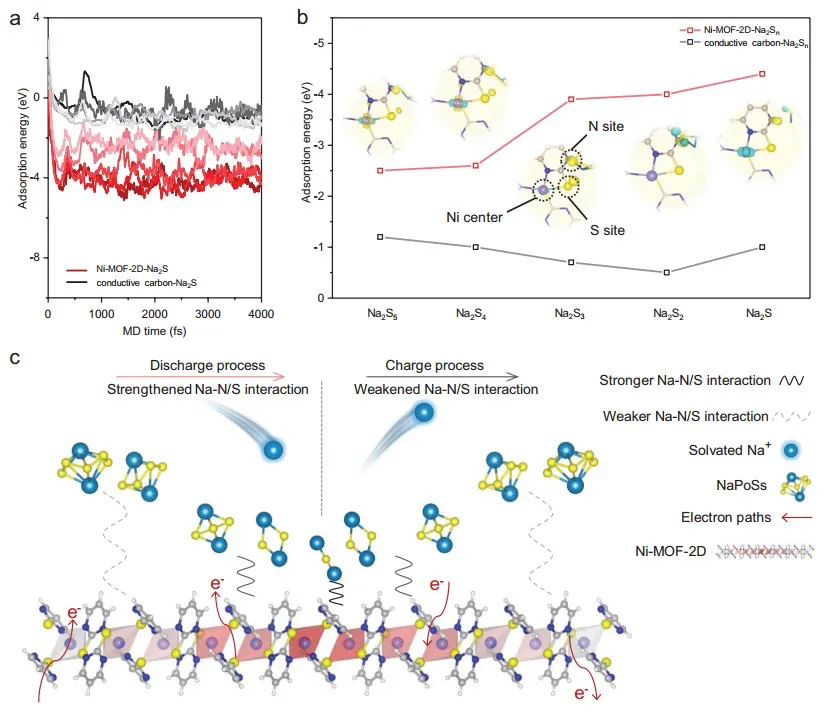
Density functional theory is used to further explain the limited region mechanism of 2D Ni-MOF on sodium polysulfide. The results of molecular dynamics calculations show that there is a strong adsorption between sodium polysulfide and 2D Ni-MOF (Figure a). Among them, the electron donors S and N atoms in the heterocyclic ligand act as the main adsorption sites and interact with the Na atoms in sodium polysulfide. During discharge, the sodium polysulfide transitions from Na2S5 to Na2S, the density of electron states of Ni atoms gradually decreases, and the adsorption energy gradually increases (Figure b, supporting information). The restricted mechanism of 2D Ni-MOF on sodium polysulfide is shown in Figure c. During the discharge, the electrons of the Ni atom are gradually transferred to the N atom through the heterocyclic ligand, which enhances the interaction between 2D Ni-MOF and sodium polysulfide, which is beneficial to the sodiumization process; during the charging process, the Na-N / S interaction gradually weakens, which is beneficial to the process of de-sodiumization. The 2D Ni-MOF Ni atom with strong redox ability dynamically adjusts the adsorption strength of sodium polysulfide and promotes the kinetic conversion process of sodium polysulfide, thus significantly improving the discharge specific capacity and cycle stability of room temperature sodium-sulfur batteries.
Summary
In this paper, synchrotron radiation in situ XRD, NEXAFS, electrochemical testing, and DFT are used to verify for the first time that the interaction between the sulfur anode and the polysulfide can be dynamically adjusted through the change in the density of the electron state of the Ni atom. It can achieve strong adsorption of polysulfides and promote its kinetic conversion process, significantly improve the discharge specific capacity and cycle stability of room temperature sodium-sulfur batteries, and provide theoretical guidance for the design of metal-sulfur battery sulfur cathode materials.
Literature information
Electron-State Confinement of Polysulfides for Highly Stable Sodium--Sulfur Batteries. (Adv. Mater., 2020, DOI: 10.1002 / adma.201907557)
Original link:
https://onlinelibrary.wiley.com/doi/abs/10.1002/adma.201907557
Source: Computational Materials
- Previous: Core-bilayer heterostr
- Next: A Rising 2D Star: Nove


 Academic Frontier
Academic Frontier
